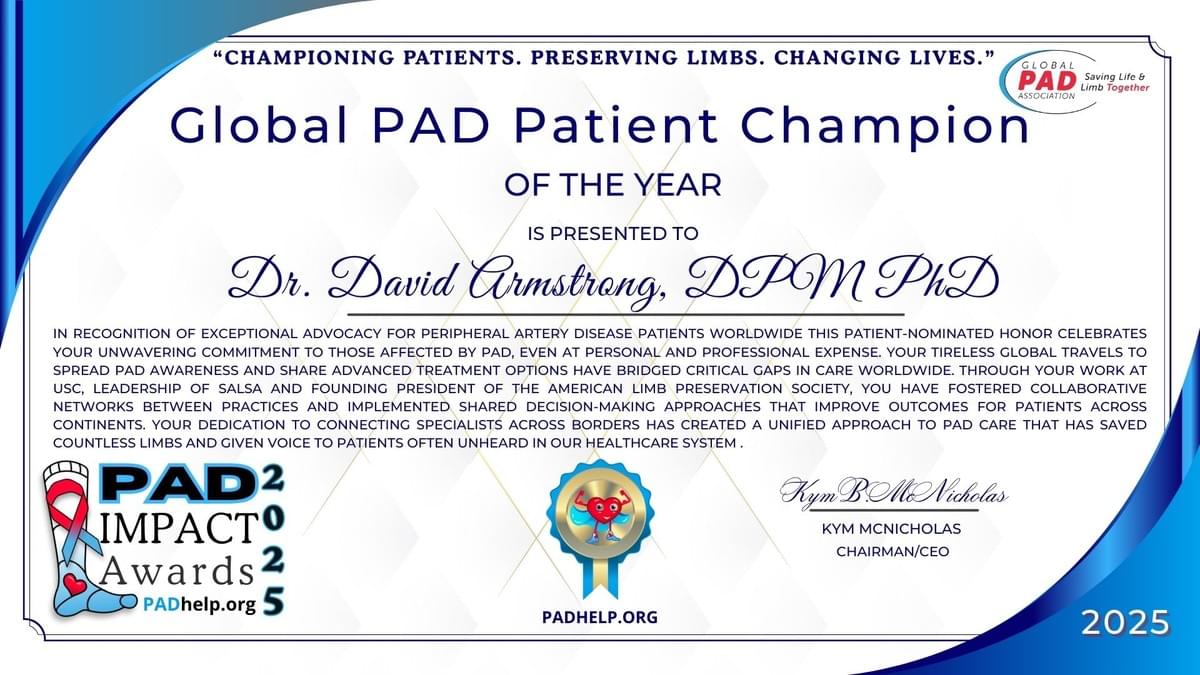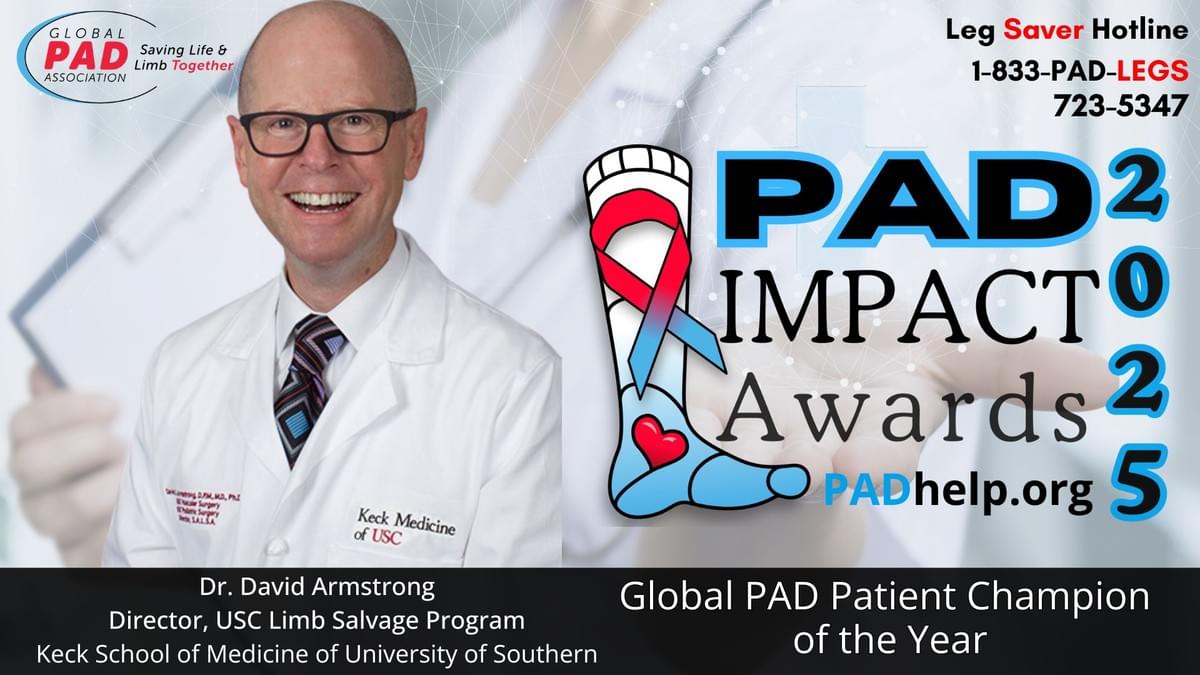The Heart of Limb Preservation: Dr. David Armstrong’s Journey From Clinic to Global Champion
It was nearly midnight on a Saturday when I received an urgent call through the Global PAD Association’s Leg Saver Hotline. A desperate patient was facing an unnecessary toe amputation scheduled for that night—with no life-threatening circumstances and no vascular evaluation beforehand. Following our protocol, I immediately reached out to Dr. David Armstrong. Despite the late hour, he responded without hesitation, guiding me to connect the patient with USC’s limb salvage team. Their assessment determined that only a minor debridement was needed—not amputation. Today, that patient walks without any problems.
This story exemplifies why Dr. Armstrong was the clear choice for the Global PAD Association’s 2025 Global Patient Champion Award. As I welcomed him to our virtual presentation ceremony, he remained characteristically humble. “I’m just a pre-op right now with one of my patients right across the street,” he explained, briefly stepping away from clinical duties to join our conversation. This seamless integration of hands-on patient care with global advocacy perfectly encapsulates who Armstrong is—a physician whose impact extends far beyond hospital walls while never losing sight of the individuals under his care.

As distinguished professor of surgery at USC, director of the Southwestern Academic Limb Salvage Alliance, and founding president of the American Limb Preservation Society, Armstrong has fostered collaborative networks that have redefined PAD treatment. But behind these impressive credentials lies a deeply personal philosophy about medicine that began in his childhood.
“I grew up in my pop’s office,” Armstrong recalled, sharing a pivotal memory from his youth. While watching his father, podiatrist Leo Armstrong, treat the mayor of their town, young David observed their engaging conversation about politics and philosophy before his father made a quick diagnosis. When Armstrong later asked how his father had identified the condition so quickly, Leo’s response became a cornerstone of his son’s approach to medicine: “Son, you totally missed it. None of that stuff matters. What matters is that folks don’t care how much you know until they know how much you care.”
Armstrong admits he nearly rolled his eyes at what seemed like a poster platitude. “But boy, do I know what he means now,” he reflected. “Patients know when you’re dialing it in, and they know when you’re giving them 100%. That matters more than anything—more than your surgical acumen or clinical acumen, although both are critically important.”
This patient-first mentality has guided Armstrong’s global efforts to build limb preservation teams. When asked about barriers to optimal PAD care internationally, he emphasized that while specific medical skills matter, the most transformative change comes from bringing diverse specialists together.
“Putting people together in almost any sort of permutation yields almost invariably a better result,” Armstrong explained. “Every country, it doesn’t matter where you are, if you could just get the right skillsets together, you can be agnostic about the specialist but evangelical about the skillset.”
This collaborative approach is bearing fruit globally. Armstrong described a recent trip to Singapore where his team helped establish limb preservation programs that never existed before. What started as conversations in hospital hallways has evolved into formal centers of excellence—what Armstrong calls “the equivalent of trauma centers for atraumatic wounds and tissue loss.”
When discussing what drives his tireless advocacy, Armstrong shared another formative childhood memory. While traveling with his father and a group of foot doctors in Leningrad (now St. Petersburg) during the Cold War, he overheard a conversation between his father and a colleague named Tilden who suggested that Armstrong’s parents leave their children at home for once and travel first class. After a pause, his father pointed to Armstrong and his brother, saying, “Tilden, that’s my Rolex over there.”
“I never forgot that,” Armstrong said, his voice softening. “And I always thought that if we ever had a chance to pay it forward, I would.”
This commitment to passing knowledge forward extends to his professional legacy as well. Armstrong speaks with obvious pride about his mentees who now lead programs worldwide. “We always say you have your kids, your personal progeny. But then you have your professional progeny,” he explained. “To me, that transcends how big your bank account is, how many cylinders you have in your car, or how many team members you have. All that stuff pales in comparison to your personal progeny and professional progeny.”
Throughout our conversation, Dr. Alper noted Armstrong’s unique ability to build bridges—not just between specialties but between approaches to care. “You represent the best of podiatry,” Alper observed, “but you’ve taken our profession and have it seen not beneath, but right shoulder to shoulder with vascular surgeons, with interventionalists, with physical therapists, with nutritionists, with every member of the team that needs to be put together to prevent this type of amputation.”
Despite his global impact, Armstrong remains grounded in the day-to-day realities of patient care—sometimes with unexpected challenges. When asked about memorable patient encounters, he shared a remarkable story about a patient whose toe was eaten by their cocker spaniel. Because of diabetic neuropathy, the patient felt no pain and prioritized the dog’s health over their own, taking the pet to an emergency veterinarian before seeking medical attention.
“Many of our patients don’t have what one of my mentors, Paul Brand, used to call ‘the gift of pain,’” Armstrong explained. “These folks will look like us and dress like us, but because of neuropathy, they will not act like us. They will do things and make decisions that you wouldn’t make if pain was guiding you.”
This profound insight into the patient experience exemplifies why Armstrong’s work matters so much. His ability to understand patients’ unique challenges while advocating for systemic improvements has saved countless limbs and lives.
Looking toward the future, Armstrong envisions continuing to formalize centers of excellence for limb preservation worldwide. “We’d like to see this grow into every kind of corner, not only of the U.S., but really around the world,” he explained. His vision includes establishing dedicated training programs and fellowships for those who want to specialize in this critical area, creating a recognized pathway for the next generation of limb preservation specialists.
His ongoing initiative with the American Limb Preservation Society (ALPS) further illustrates his approach to problem-solving. “All it aspires to be is a cross between a dating app and a marriage counselor,” Armstrong explained with characteristic humor, describing how the organization connects specialists from different fields—what he calls “toe and flow” experts—to create effective limb preservation teams. With over a thousand members already, the ALPS website helps patients and providers find the right combination of specialists in their area.
In our concluding moments together, with Armstrong needing to return to his waiting patient, the true essence of his impact became clear. He has transformed the landscape of PAD treatment not through revolutionary techniques alone, but through a revolutionary approach to care—one that values collaboration over competition, human connection over hierarchy, and sees patients as partners rather than merely recipients of treatment.
As Dr. Armstrong builds what he calls “the equivalent of trauma centers for atraumatic wounds,” he isn’t just changing medical systems—he’s changing lives, one limb at a time. In a world that often separates specialties into silos, he reminds us that the most powerful healing happens when we break down walls and build bridges instead. For patients facing the devastating consequences of PAD, this integration of care isn’t just better medicine—it’s the difference between losing a limb and maintaining independence, between surrendering to disability and reclaiming mobility, between giving up and moving forward.
Watch the FULL video interview with Dr. David Armstrong below:
If you’re experiencing symptoms of PAD—leg pain, leg cramps, neuropathy, or restless legs—don’t wait until it’s too late. The Global PAD Association’s Leg Saver Hotline (1-833-PAD-LEGS) provides immediate support for finding specialized PAD doctors in your area and offers guidance on critical lifestyle modifications including exercise programs, smoking cessation strategies, and dietary improvements.
Join our community of patients, caregivers, and advocates in the Global PAD Association’s Facebook PAD group at padsupportgroup.org. For those looking to improve circulation through movement, our dedicated PAD walking group at walkingsupportgroup.com offers support and motivation for this essential aspect of PAD management.
Disclaimer: These awards are not to be considered an endorsement for any doctor. Recipients are nominated and voted on by patients and an independent panel. Always do your homework to find the best doctor for your situation. The Global PAD Association’s hotline is available to help with this process.
